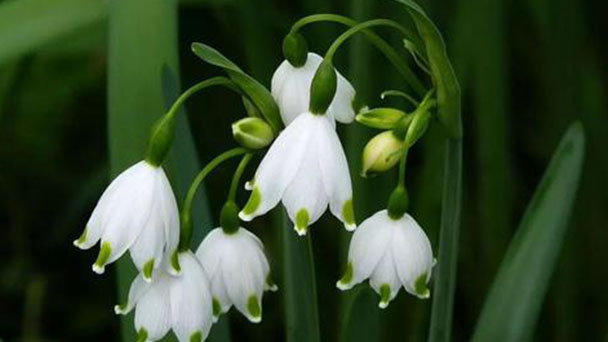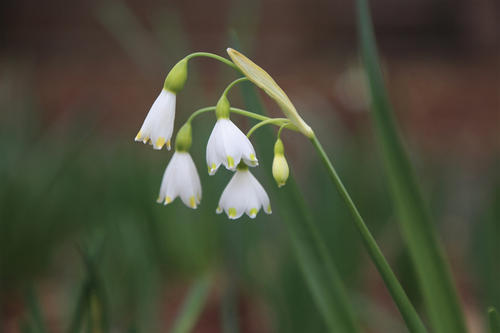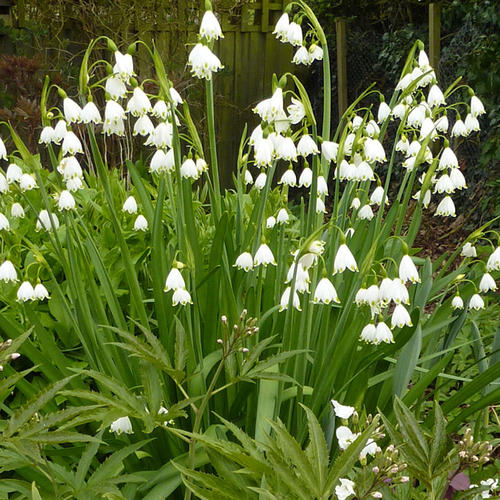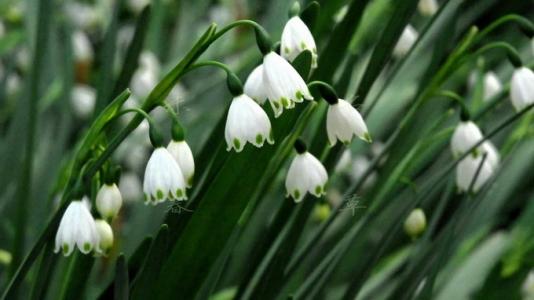Summer snowflake (Leucojum aestivum) profile
Written by Maggie
Mar 25 2021

Summer snowflake (Leucojum aestivum), also known as Loddon lily, is a perennial bulbous plant of the genus Liliaceae. Plant height is 24 ~ 36cm. Leaves are dark green, long sword-shaped. The flower stem is long and thin, the white corolla at the top is drooping, and the lampshade is shaped. The tip of each petal has green markings. Flowering period from late spring to early summer. Summer snowflake prefers full sun. The flower shape of this plant is very beautiful, is one of the bulbous flowers that like very wet conditions. Although it is a common plant in swamp gardens, it is more common in the wild along streams.
Summer snowflake picture

Morphological characteristics of summer snowflake
Stems
Summer snowflake bulbs are ovate, 2.5 -- 3.5 cm in diameter.
Leaf
Summer snowflake has several basal leaves, green, broadly linear, 30 -- 50 x 1 -- 1.5 cm, obtuse.
Flowers
Summer snowflake stems drawn at the same time as the basal leaves, hollow, slightly above or nearly equal to the leaves; Inflorescences are umbellate with 3 to several flowers, sometimes only 1, with 1 involucre below, 3 -- 4 cm long, 5 -- 10 mm wide; Pedicels are varied in length, as long as 5 cm, as short as 1 -- 2 cm; Flowers are drooping; Perianth segments ca. 1.5 cm long, white, with a green tip; Stamens are about half as long as perianth segments; Ovary is inferior, long elliptic, 5-10 mm long; Style is longer than stamens.
Summer snowflake blooms from late spring to early Summer.
Fruit
Summer snowflake capsule is subglobose, ca. 2 cm in diameter; Seeds are black.
Ecological habits of summer snowflake
Summer snowflake has a beautiful shape and is one of those bulbous flowers that like extremely wet conditions. Although it is a common plant in swamp gardens, it is more common in the wild along streams.
Summer snowflake propagation
Summer snowflake propagates by splitting the ball.

Summer snowflake care
Summer snowflake grows nicely in fertile, free soil that has everyday moisture and is well-drained. It takes both full solar or section shade, however blooms great if it receives at least 6 hours of shiny daylight a day. Tolerant of a range of soils, summer time snowflakes will adapt to dry soil and clay soil in most cases.
Plant summer snowflakes fall in drifts of 15 to 20 or greater bulbs set four to 6 inches deep and four to 6 inches apart. Water bulbs nicely after planting. After the springtime bloom, permit the foliage to continue to be till it withers and turns yellow. At that point, you can dispose of the foliage or enable it to decompose in place. During summer time dormancy, bulbs tolerate dry soil however they thrive in cool and moist soil, so blanket the soil with a 2-inch-thick layer of mulch.
As soon as the Summer snowflake blossoms, the growing bulbous roots are cut into sections and must be planted in the designed fixed position prior to drying. Although sometimes the growth state is not very good, sometimes the stem will be drawn flowers.
The area of summer snowflake
Summer snowflake is native to central and southern Europe.
Relatives of the summer snowflake
Summer snowflake is different from Galanthus nivalis, which belongs to the same family and belongs to a different genus. Summer snowflake is also known as snowdrop, small snowbell, and bell daffodil. It is also known as snowdrop. The main difference between the two genera is the difference of petals. Summer snowflake6 petals are the same, while the petals of snowdrop flower are divided into two layers, the inner layer of 3 is shorter than the outer layer of 3.
Summer snowflake uses
Summer snowflake was introduced and cultivated in China for ornamental use.

Latest Updated
- Benefits of Bugleweed - 7 Science-backed Health Benefits
- Bugleweed Dangers & Side Effects - Is It Poisonous?
- How to Plant Evergreen Trees - What You Should Know
- When to Plant Evergreens - Grow Guide for Evergreen Trees
- 12 Wonderful Evergreen Shrubs for Your Garden
- 12 Popular Evergreen Plants with Pictures for Beginners
- When And How To Prune A Lilac Bush Like a Pro
- How to Grow & Care for Lilac Vine (Hardenbergia Violacea)
- Japanese Lilac Tree (Syringa Reticulata) Care & Propagation Guide
- Shumard Oak Pros and Cons - What to Know
Popular Articles
- Winter maintenance of Antirrhinum Majus
- How to Grow Terminalia Mantaly Tree
- How to Grow and Care for Crossostephium Chinense
- How to grow Antirrhinum Majus in spring
- Peristeria Elata (Dove Orchid) Profile: Info & Care Guide
- Underwatered Snake Plant (Sansevieria Trifasciata) - Signs And How To Fix
- How to Care for Brazilian Jasmine Plant (Mandevilla Sanderi)
- How to Grow & Care for Graptopetalum Purple Delight in Summer
- Rosa Chinensis (China Rose): Plant Growing & Care Tips
- How to Care for Baby Sun Rose (Aptenia Cordifolia)